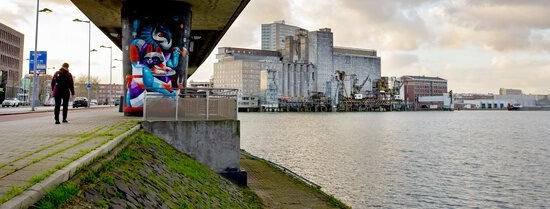The National Programme Rotterdam Zuid (NPRZ) has been in place since 2011, aiming to increase the socio-economic opportunities for residents of Rotterdam-Zuid and improve life in the area. The programme has now been underway for 13 years, with 7 years left to achieve its goals. How is it progressing, and how effective has it been so far? Sociologist Gijs Custers has conducted research on the matter. 'Zuid is improving on average, but that says nothing about what you see within that average.'
Through the NPRZ, the Dutch government, the municipality of Rotterdam, housing corporations, healthcare institutions, school boards, businesses, and residents work together to raise Rotterdam-Zuid's socio-economic standing to the average level of the Netherlands’ four largest cities. Socio-economic indicators, such as educational attainment and the number of benefit recipients, currently lag behind in the area.

Efforts to improve outcomes, such as increasing the number of children earning diplomas and the number of people finding employment, include measures like providing 10 extra teaching hours per week for children (the extended learning time programme) and funding for housing construction, demolition or renovation of outdated housing stock. Significant government funding has been invested in these initiatives. However, the effectiveness of these measures is not always easy to assess. 'The area is vast and diverse, with as many residents as Eindhoven', explains Gijs Custers, assistant professor at Erasmus School of Law. 'It’s not always clear which processes influence one another. Moreover, the programmes are not designed in a way that easily allows for evaluating their effectiveness.'
Extended learning time shows no clear impact
For example, there is no control group to compare the results of students participating in the extended learning time programme. Additionally, the nationwide replacement of the Cito test with various primary school final exams complicates assessment. Despite these challenges, the extended learning time programme does not appear to have a clear positive impact on the final recommendations for primary school pupils. 'You see that the narrative around the programme’s goals has also shifted. Initially, the focus was heavily on boosting academic performance; now, it also emphasises enrichment, aiming at broader general development.'

A mixed neighbourhood is not the same as a mixed community
Over the past decade, significant construction, demolition and renovation have occurred in Rotterdam-Zuid. These changes have not been without controversy, as seen in the resistance from residents of the Tweebosbuurt. 'The classic idea underpinning NPRZ is that a concentration of poverty exacerbates problems. However, this is a contested notion from a scientific perspective, particularly in the Dutch context. A mixed neighbourhood does not automatically result in a mixed community.'

From working-class area to affluent neighbourhood
Through NPRZ, the government has exerted significant influence over the housing stock in Zuid and who can live there. Housing has also been built for higher-income residents, such as the new apartments in Katendrecht. Over 25 years, the area has transitioned from a working-class neighbourhood to an affluent one. For example, the WOZ property value per square metre has tripled between 2013 and 2023. Custers describes this as an "extreme example" of gentrification.
Securing a home is becoming increasingly difficult for locals in Zuid
Are the new homes actually occupied by people who, for instance, were born and raised in IJsselmonde? 'This largely depends on the type of new construction. Expensive new-build homes are less likely to be occupied by people already living in Rotterdam-Zuid. The higher the WOZ property value of the new builds, the more often they attract residents from outside Rotterdam-Zuid', explains Custers.

He highlights an interesting statistic: social climbers in Rotterdam-Zuid – those whose income increases over a few years – still tend to have relatively lower incomes compared to social climbers from Noord. 'This has implications for when a home becomes available in Zuid. Income and assets then become decisive factors. It’s often easier for outsiders to secure a home than for locals from Zuid.'
Who is the programme actually for?
The programme focuses on socio-economic progress and operates largely in a top-down manner, according to Custers, though its scope has broadened somewhat in recent years. For instance, there is little attention given to the ‘softer’ side of a community, such as community centres and social amenities. This raises a values-based discussion, he suggests: what is the ultimate goal for Zuid, and when can we say it’s doing well, particularly for people with low incomes? Following on from this: who is allowed to live in Zuid?

Growing divides within Zuid
'You could argue that NPRZ is effective because, according to its own metrics, Zuid is catching up on multiple fronts. But this must be seen in the context of gentrification in Rotterdam', says Custers. 'The divides within Zuid are also becoming sharper. You have areas like Kop van Zuid, Katendrecht and the Entrepot district – the "tail end of Noord" – and then the neighbourhoods further south. Those areas are changing too, but not as quickly.'
For example, Katendrecht is now home to Rotterdam’s most expensive apartment, the ‘Bay House’, which sold for €10 million. 'From that apartment, you overlook one of the poorest neighbourhoods in the Netherlands. These realities literally exist side by side. Zuid is improving on average, but that says nothing about the disparities within it.'
- Professor
- More information
More science stories? View our online magazine Erasmus Extra.
Press?
Questions? Get in touch with press officer Ronald de Groot.- Related content
- Related links
- Pointer (NPO Radio 1) episode with dr. Gijs Cluster: Inequality of opportunity in education (in Dutch)

